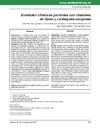Please use this identifier to cite or link to this item:
https://accedacris.ulpgc.es/jspui/handle/10553/43724
| Title: | Evolución clínica en pacientes con síndrome de Down y cardiopatía congénita | Other Titles: | Clinical evolution in patients with Down syndrome and congenital heart disease | Authors: | Martínez Quintana, Efrén Rodríguez-González, Fayna Medina-Gil, J. M. Ágredo-Muñoz, Julio Nieto-Lago, Vicente |
UNESCO Clasification: | 320501 Cardiología 320704 Patología cardiovascular |
Keywords: | Congenital heart disease Down syndrome Pulmonary hypertension Cardiopatía congénita Síndrome de Down, et al |
Issue Date: | 2010 | Publisher: | 0009-7411 | Journal: | Cirugía y cirujanos | Abstract: | Background: Long-term complications of Down syndrome patients with congenital heart disease are poorly known. methods: We carried out a retrospective study of Down syndrome patients with congenital heart disease and patients with atrioventricular septal defect with and without Down syndrome. results: Between 2004 and 2008, 317 patients with congenital heart disease were followed-up in the Adult Congenital Heart Disease Unit. Of these patients, 19 (6%) with a mean age of 26.8 ± 8.1 years had Down syndrome. Atrioventricular septal defect was the most frequent congenital heart disease (63%) followed by ventricular septal defect (26%). Ten patients (53%) were operated on during childhood. Three of these patients required reoperation during adulthood (two patients due to left ventricle outflow tract obstruction and one patient due to left atrioventricular valve insufficiency). Four patients (21%) had Eisenmenger syndrome with improvement of functional class in those treated with bosentan, two patients (10.5%) had bacterial endocarditis and two patients (10.5%) died. No significant differences were seen in left atrioventricular valve insufficiency between atrioventricular septal defect in patients with and without Down syndrome (1.5 ± 0.9 vs. 1.7 ± 0.8, p = 0.689). Conclusions: Left atrioventricular valve insufficiency and left ventricle outflow tract obstruction were the most frequent long-term complications requiring surgical reintervention in patients with atrioventricular septal defect. introducción: La evolución a largo plazo de pacientes con síndrome de Down y cardiopatía congénita es poco conocida.material y métodos: Estudio retrospectivo de pacientes con síndrome de Down y cardiopatía congénita y pacientes con de-fecto del tabique auriculoventricular y sin trisomía 21.resultados: Entre 2004 y 2008 se hizo seguimiento a 317 pacientes con cardiopatía congénita; 19 pacientes (6%) con edad media de 26.8 ± 8.1 años tenían síndrome de Down. Las cardiopatías congénitas más frecuentes fueron el defecto del tabique auriculoventricular (63%) y la comunicación interven-tricular (26%); 10 (53%) habían sido intervenidos quirúrgica-mente en la infancia, tres de ellos con defecto auriculoven-tricular completo requirieron reintervención en la edad adulta (dos por obstrucción al tracto de salida del ventrículo izquierdo y uno por insuficiencia severa de la válvula auriculoventricular izquierda); cuatro (21%) desarrollaron hipertensión arterial pul-monar, con mejoría del grado funcional al recibir tratamiento con bosentan; dos (10.5%) tuvieron endocarditis bacteriana; dos (10.5%) fallecieron. No existieron diferencias en el grado de insuficiencia de la válvula auriculoventricular izquierda (1.5 ± 0.9 versus 1.7 ± 0.8, p = 0.689) entre pacientes con defecto auriculoventricular con y sin síndrome de Down. Conclusiones: La insuficiencia de la válvula auriculoventricu-lar izquierda y la obstrucción al tracto de salida del ventrículo izquierdo fueron las causas más frecuentes de reintervención en la edad adulta en pacientes con defectos del tabique auri-culoventricular. |
URI: | https://accedacris.ulpgc.es/handle/10553/43724 | ISSN: | 0009-7411 | Source: | Cirugia y Cirujanos [ISSN 0009-7411], v. 78 (3), p. 245-250 |
| Appears in Collections: | Artículos |
SCOPUSTM
Citations
16
checked on Jun 8, 2025
Page view(s)
37
checked on Mar 2, 2024
Download(s)
47
checked on Mar 2, 2024
Google ScholarTM
Check
Share
Export metadata
Items in accedaCRIS are protected by copyright, with all rights reserved, unless otherwise indicated.
